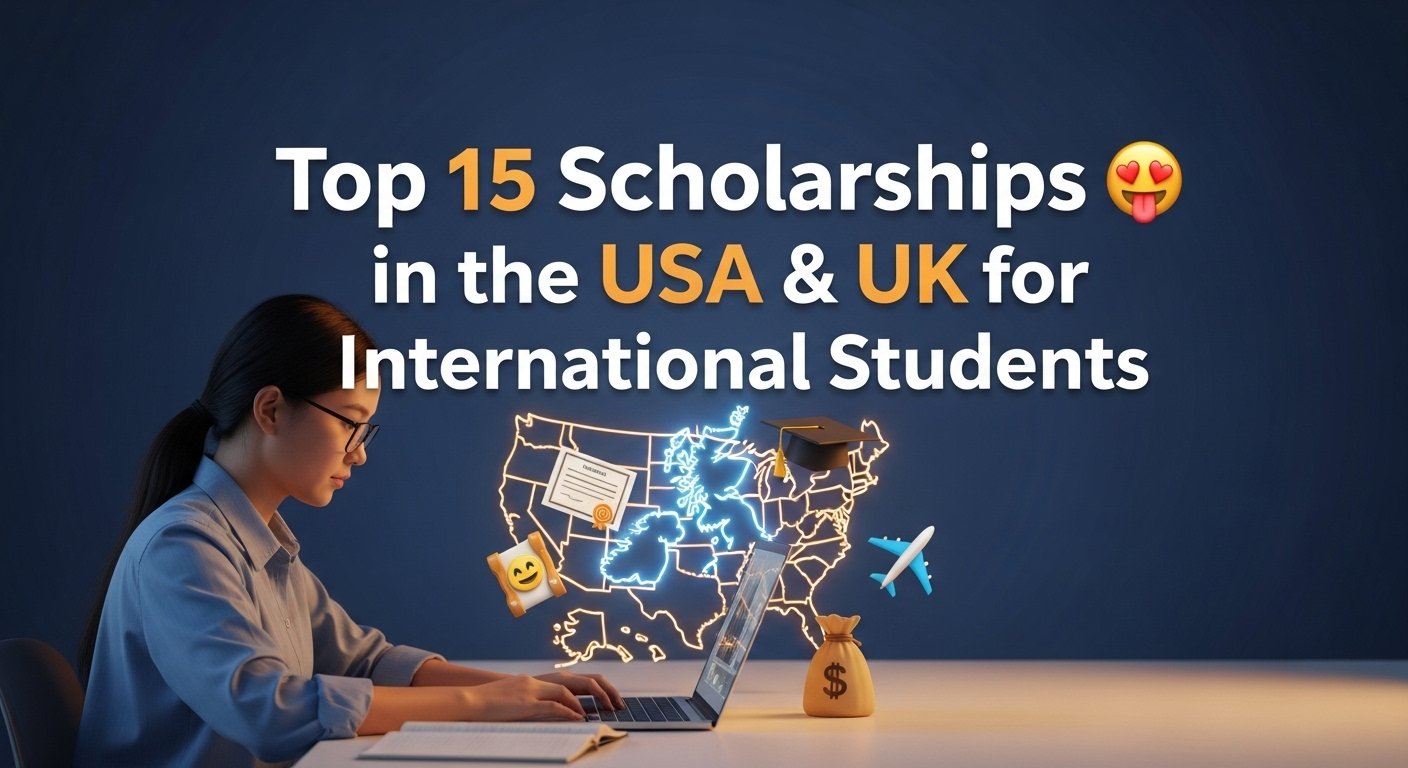Scholarships for International Students — Top 15 USA & UK Awards (2025)
Introduction — why scholarships still matter (and how to use them wisely)
Studying abroad can change your life, but tuition and living costs are the biggest roadblocks. Scholarships for international students don’t just help pay bills — they can open professional networks, provide mentorship, and sometimes guarantee internships or placements. This guide lists 15 reputable funding paths in the USA and UK, explains who they suit, and gives practical steps to prepare strong applications. I’ll also share a realistic timeline and application checklist so you can plan like a pro.
How this guide is organized (so you don’t waste time)
- Short profile for each scholarship: what it covers, who it’s for, and one practical tip.
- A comparison table for quick scanning.
- A step-by-step application checklist and timeline.
- Real-world tips to make your application stand out.
Where it helps, I link to official program pages so you can confirm exact deadlines and country-specific rules. (Always double-check the official site before applying — programs update eligibility and deadlines regularly.) Fulbright Foreign ProgramChevening

Quick comparison — at-a-glance
| Scholarship | Host country | Level | Typical coverage |
|---|---|---|---|
| Fulbright Foreign Student | USA | Masters / PhD | Tuition, living stipend, travel (varies). Fulbright Foreign Program |
| Chevening | UK | Masters (1 year) | Tuition, living allowance, travel. Chevening |
| Rhodes | UK (Oxford) | Postgraduate | Tuition + living stipend; highly competitive. Rhodes House |
| Gates Cambridge | UK (Cambridge) | Postgraduate | Full-cost to Cambridge (fees & maintenance). Gates Cambridge |
| Knight-Hennessy (Stanford) | USA | Graduate | Full support + leadership program. knight-hennessy.stanford.edu |
| Commonwealth Scholarships | UK | Masters / PhD | Tuition, stipend for Commonwealth citizens. Commonwealth Scholarships UK |
| Clarendon Fund (Oxford) | UK | Graduate | Fees + living grant (merit-based). University of Oxford |
| JJ/WBGSP (World Bank) | Global partners | Masters | Full funding for development fields. World Bank |
| AAUW International Fellowships | USA | Graduate / Postdoc (women) | Stipends for study/research. Rhodes House |
| Hubert H. Humphrey Fellowship | USA | Mid-career (non-degree) | Living allowance & professional development. Fulbright |
| Rotary Foundation Global Grants | Global | Graduate / Projects | Variable grants for study / projects. Fulbright Online |
| GREAT Scholarships (British Council) | UK | Masters | Partial tuition awards via partner unis. World Bank |
| Mastercard Foundation Scholars | Global partners | Undergrad / Grad (Africa focus) | Full scholarships at partner schools. knight-hennessy.stanford.edu |
| University merit/need aid | USA/UK | Undergrad / Grad | Varies; some top schools meet full need. Commonwealth Scholarships UKGates Cambridge |
| Misc. country & industry funds | Global | Varies | Government & private foundation awards — search locally. |
The 15 scholarships — short, practical profiles
1) Fulbright Foreign Student Program (USA)
Who it’s for: Graduate students, young professionals, artists from participating countries.
What it covers: Funding levels vary by country but typically include tuition, a living stipend, and travel. Apply through your country’s Fulbright commission or U.S. embassy. Fulbright Foreign Program+1
Pro tip: Fulbright often emphasizes cultural exchange and long-term impact — craft an application showing how you’ll use U.S. study to benefit your country.
2) Chevening Scholarships (UK)
Who it’s for: Emerging leaders seeking a one-year master’s in the UK.
What it covers: Tuition, living allowance, return flights, and alumni network access. Applications open annually through a central portal. Chevening+1
Pro tip: Chevening looks for leadership potential and a clear post-study plan; your essays must show concrete impact.
3) Rhodes Scholarships (University of Oxford, UK)
Who it’s for: Exceptional graduates with leadership and academic excellence.
What it covers: Tuition, stipend, and membership of the Rhodes community. Extremely competitive; regional rules apply. Rhodes House
Pro tip: Demonstrate character, leadership, and a plan to contribute to society — references and interviews are crucial.
4) Gates Cambridge Scholarships (University of Cambridge, UK)
Who it’s for: Outstanding international postgraduate applicants to Cambridge.
What it covers: Full cost of study (fees plus maintenance). Selection emphasizes academic excellence and social purpose. Gates Cambridge
Pro tip: Highlight both rigorous scholarship and concrete plans to apply your work to real-world problems.
5) Knight-Hennessy Scholars (Stanford, USA)
Who it’s for: Graduate students (any nationality) entering Stanford degree programs.
What it covers: Up to three years of full funding plus leadership training and cohort activities. knight-hennessy.stanford.edu
Pro tip: Knight-Hennessy values breadth — show interdisciplinary curiosity and leadership track record.
6) Commonwealth Scholarships (UK)
Who it’s for: Citizens of eligible Commonwealth countries for masters/PhD.
What it covers: Tuition and maintenance in many cases, focused on development outcomes. Apply via national nominating bodies or national competitions. Commonwealth Scholarships UK
Pro tip: Emphasize how your study will contribute to development in your home country.
7) Clarendon Fund (University of Oxford)
Who it’s for: High-achieving graduate applicants to Oxford.
What it covers: Full fees plus generous living grant; candidates are often auto-considered when they apply to Oxford. University of Oxford
Pro tip: Strong academic record is vital — you don’t submit a separate Clarendon application in most cases.
8) Joint Japan/World Bank Graduate Scholarship Program (JJ/WBGSP)
Who it’s for: Professionals from eligible developing countries aiming at development-focused masters.
What it covers: Tuition, travel, and living allowance at partner degree programs. Candidates must show work experience and commitment to return home. World Bank+1
Pro tip: Carefully match your application to eligible degree programs — only specific programs are partner institutions.
9) AAUW International Fellowships (USA, for women)
Who it’s for: Women (non-U.S. citizens/permanent residents) pursuing graduate or postdoctoral study in the U.S.
What it covers: Stipends for academic and professional development. Rhodes House
Pro tip: Emphasize academic excellence and how the fellowship will help you advance women or girls in your community.
10) Hubert H. Humphrey Fellowship (USA — non-degree)
Who it’s for: Mid-career professionals seeking professional development without a degree.
What it covers: Living allowance, program costs, and leadership training at a U.S. host university. Fulbright
Pro tip: Demonstrate significant professional achievements and a clear plan for applying new skills back home.
11) Rotary Foundation Global Grants (global)
Who it’s for: Candidates with a sponsoring Rotary club, often for study or humanitarian projects.
What it covers: Variable — funds can support graduate study or community projects. Fulbright Online
Pro tip: Engage with local Rotary clubs early; volunteer/service history strengthens applications.
12) GREAT Scholarships (British Council — UK)
Who it’s for: Students from partner countries applying to participating UK universities for master’s programs.
What it covers: Partial tuition bursaries (amounts vary by program). World Bank
Pro tip: Check the British Council’s annual list; GREAT awards rotate subjects and partner universities.
13) Mastercard Foundation Scholars (partner universities)
Who it’s for: High-potential students (often Africa-focused) at partner universities worldwide.
What it covers: Full scholarships plus mentorship and career development. knight-hennessy.stanford.edu
Pro tip: Review partner university pages for application routes — each partner manages its own intake.
14) University merit & need-based aid (USA/UK)
Who it’s for: Varies — some elite institutions provide need-based aid to internationals (less common at graduate level in the U.S.).
What it covers: From partial tuition to full demonstrated-need coverage depending on the institution. Commonwealth Scholarships UKGates Cambridge
Pro tip: Look for explicit international-student financial aid policies in the university’s admissions/financial aid section — don’t assume availability.
15) Country & industry-specific scholarships (local + private foundations)
Who it’s for: Varies widely — governments, companies, and foundations often fund outbound study for specific sectors or regions.
What it covers: Can range from small stipends to full funding for a degree abroad.
Pro tip: Search your country’s ministry of education, large national corporations, and sector associations for local scholarship calls.

How to choose which scholarships to apply for — a simple scoring system
Create a spreadsheet and score each opportunity across five axes (0–5): Eligibility fit, Coverage (how much it pays), Likelihood (competitiveness), Timeline (how soon you can apply), and Impact (how it advances your goals). Prioritize scholarships with high fit and meaningful coverage. Apply to a mix: one or two ambitious, plus several realistic/local awards.
Application checklist — what to prepare (start early)
- CV/resume focused on achievements and impact.
- Personal statement / project proposal tailored to the scholarship’s mission.
- Academic transcripts (official translations if needed).
- Proof of work experience (for mid-career awards).
- Strong references — brief recommenders and give them a one-page summary.
- Language tests (TOEFL/IELTS) or GRE/GMAT where required.
- Online portfolio or project links when applicable (GitHub, publications).
Start gathering these materials 9–12 months before deadlines for major awards (Rhodes, Chevening, Fulbright). knight-hennessy.stanford.eduChevening
Timeline — when to start and key milestones
- T − 12–18 months: Shortlist scholarships and check eligibility.
- T − 9–12 months: Prepare tests and draft personal statements.
- T − 6–9 months: Secure referees & finalize documents.
- T − 3–6 months: Submit scholarship applications; apply to universities if required.
- T − After acceptance: Complete visa and travel steps; confirm funding in writing.
Common mistakes applicants make — and how to avoid them
- Applying late — deadlines are strict; early submission is safer.
- Generic essays — tailor every statement to the scholarship’s goals.
- Weak references — provide referees with context and deadlines.
- Ignoring small funding routes — local foundations and employer schemes add up.
The Ultimate Guide to Distance Learning in the USA — How to Choose, Succeed & Stay Accredited
Final thoughts — be strategic, not scattershot
Winning a major scholarship is competitive, but you can improve your odds by focusing on fit, telling a clear impact story, and applying early. Mix aspirational awards (Rhodes, Gates) with reliable regional or university funding. Even partial awards + university aid + part-time work can make study abroad possible.
Call to Action (CTA)
Tell me your country, level (undergrad/masters/PhD), and field — e.g., “UK, Masters, Public Health” — and I’ll return a tailored short list of the top 5 scholarships to apply for plus a 12-month timeline and a sample one-page personal statement for one top award.
Key official resources
- Fulbright Foreign Student Program. Fulbright Foreign Program
- Chevening Scholarships. Chevening
- Rhodes Scholarships (Oxford). Rhodes House
- Gates Cambridge Scholarships. Gates Cambridge
- Knight-Hennessy Scholars (Stanford). knight-hennessy.stanford.edu
- Commonwealth Scholarships (CSC). Commonwealth Scholarships UK
- Joint Japan/World Bank Graduate Scholarship Program. World Bank




Pingback: Best Online MBA Programs in 2025 - PaidScripts — Tech Education Hub: Coding, Courses & Student Resources